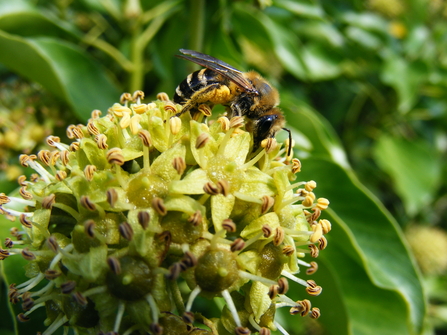For me, ivy is both misunderstood and underrated. Noted for its climbing stems and thick encircling foliage, shiny and ever-green, it twists around trees and engulfs neglected buildings. It binds hedgerows and woodlands, and when cross-stitched with brambles and honeysuckle, it makes them dense and verdant. In late autumn, when little else is available for nectar-feeding insects, ivy provides a bounty of yellow-hued blossom. A diverse set of insects feed upon it, and it is essential for red admiral, comma and peacock butterflies. The energy it provides enables them to turn the rich nectar into fat, without which they would struggle to survive hibernation. Like the bramble flowers of summer, a naturalist can become lost in time watching the multitude of insects that are attracted to its musky-smelling bloom. And at night, a hand torch reveals an array of moth species feeding lustily upon it. The ivy, of course, benefits from this army of pollinators, and the result is hard black berry-like fruit. Ripening in winter, the ivy provides these sweet riches for thrushes to feed on, and this seasonal bounty is particularly important for our wintering warbler, the blackcap.
Clinging to veteran oaks, some ivy stems at their base can be as thick as a prop forward's leg, and if left unhindered, many will grow to be as old as the tree itself. Ivy is steeped in myth and mistaken beliefs. Unfortunately, there is still a misconception that it is a parasite or that they ‘strangle’ trees. The saddest sight is when ignorance and a chain-saw combine to slice through the ivy stems around a large oak trunk, eventually leaving the tree with a cardigan of dead brown ivy leaves. Many of these mature ivies probably help hold tired old trees up!
Like the holly, ivy is one of the few native woody plants that remain green through the winter. As a result, it was considered magical and played a part in pagan worship as a sign of fidelity. This reverence of ivy continued into Christianity, and no traditional Christmas garland is complete without a woven sprig of ivy. It was also believed that during Christmas merriment, placing an ivy garland on one’s head would prevent the wearer from getting drunk. Ivy was also a mark of intellectual and sporting achievement. In ancient Greece, it was actually ivy that formed the laurel that was used to crown winners of poetry or athletic events. The ivy leaf shape is instantly recognizable, and its symbolism and form have been used in jewellery, carving and illustration since the dawn of human creativity.


